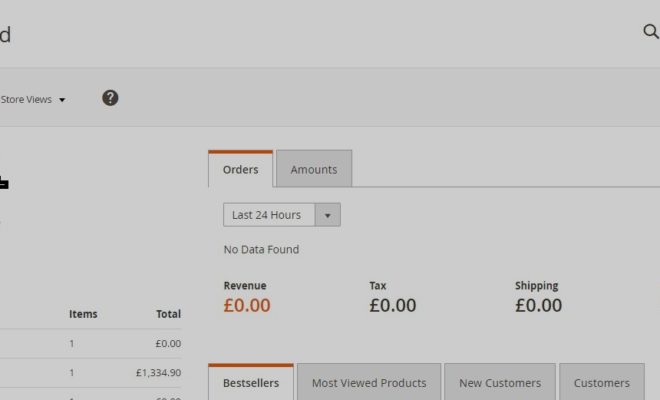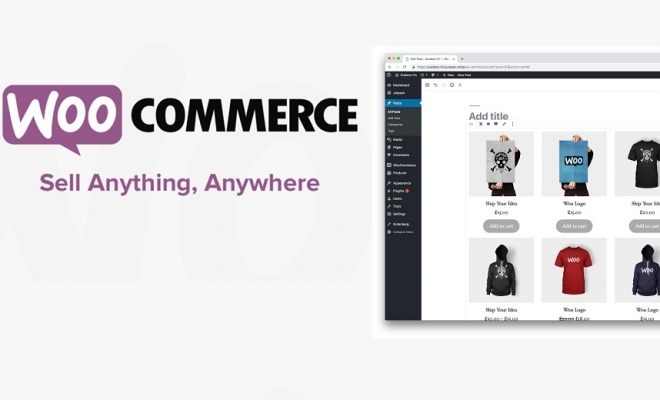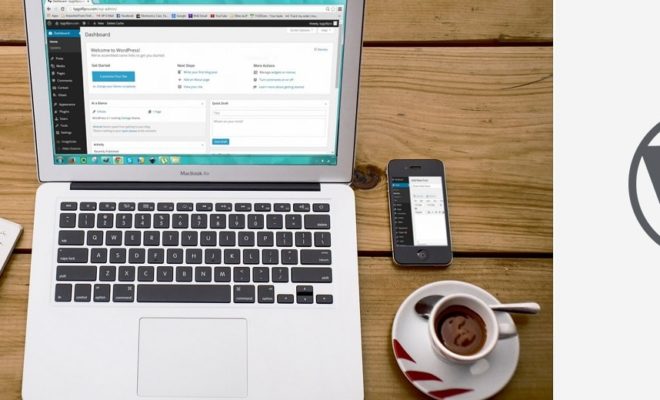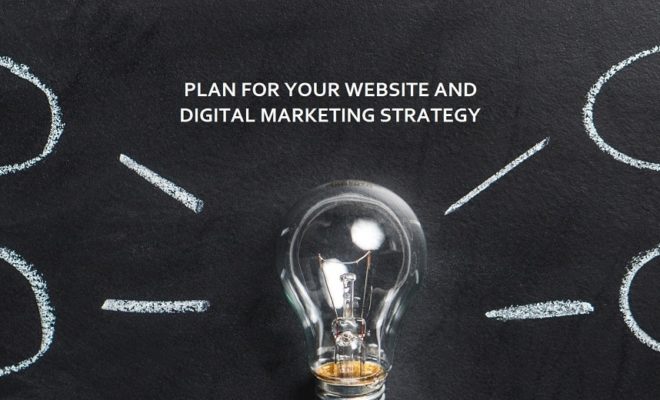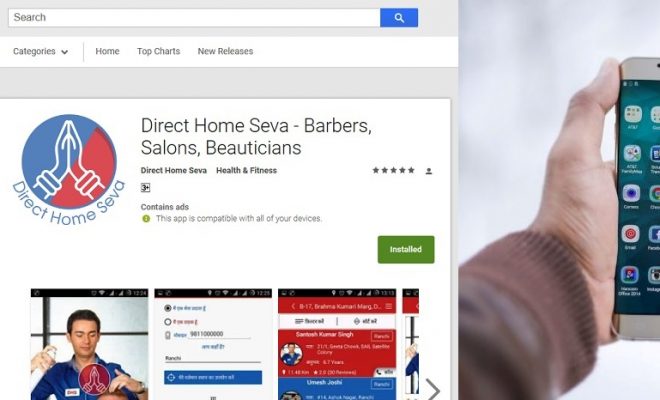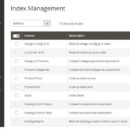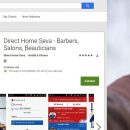Part 2 of a series of Tutorials on : Web Design and Digital Marketing for Business Owners
According to a study by Stanford on web credibility, 75% of consumers claimed that they judged a business’ credibility based on its website design.And a big part of getting your website design right is knowing which type of website does your business actually need (Static, Dynamic, CMS…or none of these ). This requires asking yourself some tough questions & doing some market research to understand your customers better.
You may have already done that but If not, you can complete this simple step by checking out our first tutorial here. Once this exercise is complete, its time to take a look at what choices you have available when it comes to website design.
Well, there is good news and bad: The good news is that…..there are plenty of choices , in all sizes and shapes.
And the bad news is… yes, there are plenty of choices but you need to make the right choice.
As a new business owner or entrepreneur; you need to decide what kind of website you will be starting out with and what features you absolutely need. Money and time are critical for new startups and businesses. So here’s a look at the Types of website design with Pros / Cons and Usage.
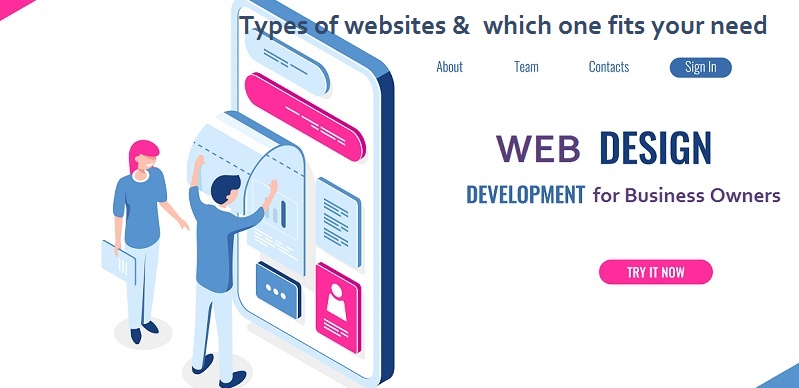
| Website Type & Usage | Pros | Cons |
| 1. The Static Website: A static website simply contains a website designed without using backend database, 3rd party content or CMS. Pages designed remain fairly unchanged, and new content is not added that regularly. Choose this when: When content is condensed and single product or service to be showcased quickly. Details provided below – can be a single page static or multi-page static website. Pros: Easier to build | Cost Effective | Useful when single focused service or product which can be explained in short. Cons: Lower interactivity with consumers, lower freshness and appeal. Cannot be used for blogging. Limitation in functionality. |
| 2. The Dynamic Website: The dynamic website as the name suggests does not show static content for the most part. The content is dynamic because it normally comes from a database , a content management system or 3rd party sources which keep refreshing the content. Ability for users to log in, do transactions such as make purchases, view products and services which can be modified frequently and much more is provided.
Choose this when: When content changes frequently or the page and content needs refreshing frequently, or when functionality requires database interaction. Pros:Useful for blogging, membership websites, job search websites, portals, e-commerce etc. Cons: More investment than simple static websites, more time consuming and involving. Requires regular updates and focus. Biggest Pitfall: Inadequate planning, structure and features not well thought and inadequate budget at times. Oversimplifying or over-complicating the requirements. |
| 3. The E-commerce Website: The e-commerce website allows you to sell your products or services online. It can be quite simple and built using simple to use hosted platforms like Shopify or can be quite complex on self-installed and customized complex platforms like Magento. It can be multi-country, multi-seller as well as B2B with inquiry interface.
Choose this when: Seems pretty obvious – so you choose this when you are selling some product or even a service. It can be anything from a simple single product e-commerce website to a complex, large multi-vendor e-commerce portal. The biggest differentiating factor of-course being the payment gateway which any e-commerce website requires. Broadly, there are 2 options for development: In the ‘Self Hosted’ options such as Magento, Opencart etc. you have flexibility of hosting and installing the platform at any 3rd party hosting provider and more flexibility in customizing current features or adding new one – apart from the pre-built ones. You are only charged regularly for the hosting (if the platform is open-source and free), as the development is a one-time charge. Pros: An e-commerce website directly reaches customers, sells your product and gets you revenues | You can sell products and services without physical presence across the globe. | Sell products even without inventory and stocking using Dropshipping | You Pocket more revenue than you would when selling on Large 3rd-party e-commerce portals. You can also become an aggregator by setting up an online-marketplace. Cons: Difficult to scale an e-commerce store unless you have great SEM and SEO skills | Needs more commitment, maintenance, merchandising, regular updates. | Can require a small to high investment, especially if mobile app is also created. |
| 4. The WordPress Website: The wordpress website is a CMS or a content management system backed website and the prime example of a dynamic website, which means the content and features of the website are provided through a database back-end.
Choose this when: you want a quick, easy, feature filled Dynamic website. WordPress is a truly flexible and scale-able platform for dynamic sites and the ideal choice for news, blogging, membership, job portal and other such websites. Using the power of plugins, functionality can be extended to many other business types and custom features. Pros: Cost effective as well as scale-able de-facto solution. Large news sites, membership sites, corporate sites, real estate sites, e-commerce sites (using Woocommerce) can all be powered using WordPress | Open source backed by large helpful community and plugins. WordPress even has an API for mobile usage. Cons: Not many but does require maintenance and regular check on security , upgrades, plugin changes. | Some expertise is required to get best performance and functionality so not as simple as a static website. |
| 5. The custom web application: Occasionally, a simple static website or CMS does not fit the requirement. That’s when we need something that is created using both design and programming and called a web application. It is more than a website and normally has many features such as: user signup, login, notifications and many custom functions.
Choose this when you need a dynamic data driven website and WordPress or other CMS , e-commerce etc. platforms are not suitable. Or when scale, scope, security and / or mobile usage requires you to build a custom solution.: Pros: Ability to fully customize your needs. | Suitable when custom back-end needed, especially in case of mobile app being used together with the web application. Cons: Will take a longer time to build than WordPress, other CMS, static sites. | Higher investment. | More involvement and greater expertise by development agency. |
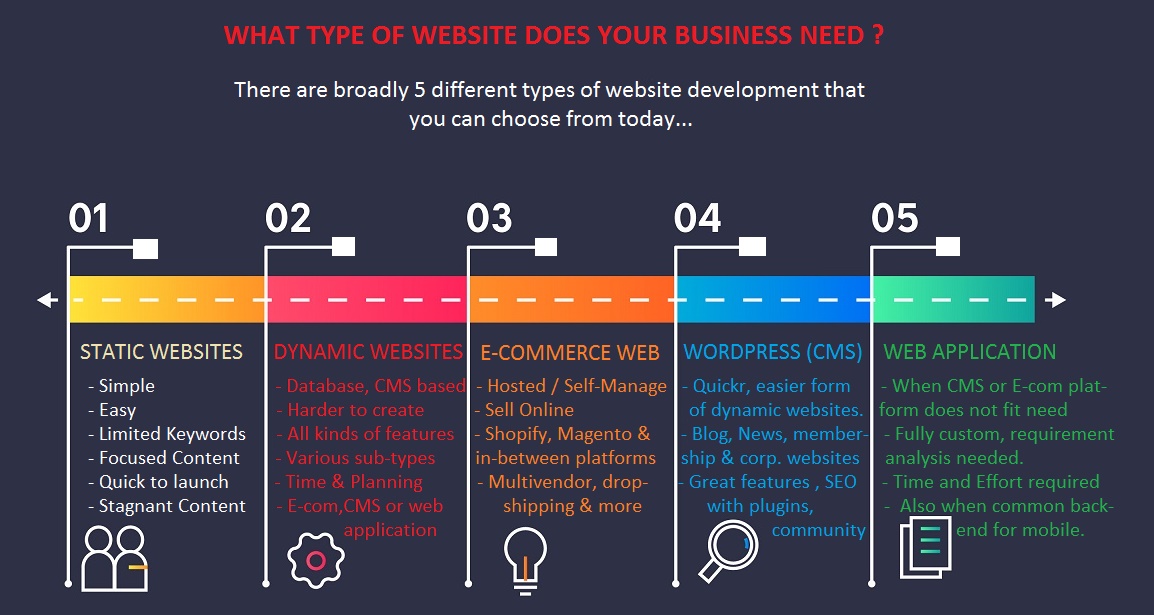
Should you develop a one-page static website or normal multi-page static website.
We have been asked this questions quite a few times by clients: so let’s look at the options available in case of static websites:
A single page website is a good option when the business or product offering does not need a lot of content or explanations & details. Only a brief introduction is sufficient and the content can be condensed into a single page.
A single page website does not mean that the content isn’t ordered or there isn’t any menu structure. It will still be there, but all the content will be in single physical page.
One of the biggest advantages of a single page website is great load / transition speed because essentially it is the same page and just the content getting displayed / hidden for specific sections. There is more scrolling, less clicking and user engagement increases.
Such a website can be a landing-page website with long-form content eventually leading the customer to take a specific action or a resume website with links / carousel / gallery of portfolio items. It may even be a small café / coffee shop website, an artist website or an App-website driving downloads and clicks to the app.
A single page website will also consume a slightly lesser budget (unless it has many complex elements).
However there are some ‘cons’ to a single page website – which make it unsuitable in some situations. These are:
a) When there is too much content, too much data or information to present and explain.
b) Limitation for Keyword Optimization
c) Giving Impression of a hurried Attempt
d) Low incentive for regular interactions due to static content.
What exactly is a dynamic website and what do you need to get it build?
Have a look at the definition of a dynamic website in the table above. Anything that’s database or content management system driven is a dynamic website. But even a dynamic website isn’t a one size fits all solution.
You have dynamic websites which are based on content management systems such as WordPress or Joomla.
And an e-commerce website is another special type of dynamic website.
Then you have the custom web applications which require programming apart from just web design. These could be websites which have features which can’t be build with CMS or pre-built extensions called ‘plugins’ . These could be custom portals or real-estate websites, classified directories, rental or sale websites, financial trading websites. So dynamic website is a generalized term as such and can have simple to pretty complex options.
To get it developed, as a rule of thumb , a proper list of requirements, features is needed. Then it needs to verified if these can be satisfied and scaled as required using existing CMS, e-commerce platform. If not or if there are other considerations, such a web-application will require choice of a technology platform for back-end and front. Programming languages ranging from Ruby, Python, Microsoft dot.net etc. can be considered for backend. This an in-depth exercise and we will take this up in detail in future tutorials.
Why is wordpress one of the best options for developing a dynamic website ?
We had written a detailed article on how to use wordpress for membership and some other types of dynamic websites. Not just membership but other dynamic website types such as news, blogging, training etc. websites can be built swiftly and smoothly using WordPress.
Why ?
Because developing a dynamic website can be costly and time-consuming if done through custom programming. An easier way is to build such website using a content management system and add-on pre-built tools called plugins – if the functionality fits. WordPress is most popular CMS available and has thousands of pre-built plugins available which can add on many complex features. It is proven, scaleable (powers some of the largest corporate websites) and great for search engine optimization. It has a huge community of developers, users supporting it through plugins, forums, training resources, documentation etc. It is relatively easy to host and maintain.
What are the options available when you need an e-commerce website for your business
We have worked with many clients who have launched their products online. One of the main advice that we offer to clients about e-commerce websites is to look at their launch plan in totality and think also about how they will market the products online. An e-commerce website needs to be supported by good SEO, PPC ads and/or SEM (search engine marketing) , SMM and email marketing to drive traffic which will actually lead to the sales. The options available to you are ‘Hosted’ platforms such as Shopify (where the site platform and hosting are provided in an integrated manner) OR self-managed where you set-up, customize, arrange the hosting of the website and have typically more control on it is.
In terms of business model, e-commerce websites are typically simple online stores or multi-vendor portals/Marketplace. In the marketplace model you are the aggregator and actual sellers are other vendors who are able to manage their product (with some checks and balances) on your site. Once sold, you are paid the payment and pass on a net amount minus the marketplace fee /commission etc. to the sellers. Dropshipping is another great model in e-commerce where you are able to sell online without the worry of investing in inventory, packaging, manufacturing etc.
Why is all this important for you as a business owner ?
Well, because being involved in the web design and digital marketing of your new business allows you to be in control of the costs and quality in a better way. Knowing what’s possible and what’s not can help you when dealing with your website design company or agency. As a business owner, if you understand the above types of websites, their pros and cons and the typical situations they are suitable for; you will have an easier time working with your vendor, partners and in the overall implementation and running of the website.
At the end, I would like to leave with an interesting quote if I may: “If you don’t know where you are going, any road will take you there.”
So , study the choice of website design available to you and discuss the same with your prospective web design partner. Get ideas and insights before embarking on the journey of developing your website. In our next tutorial we will look at how to get a Project Plan and Requirements Document ready for your website / web application.

